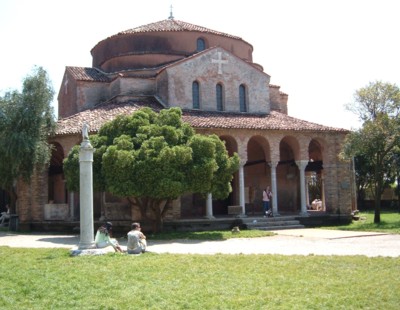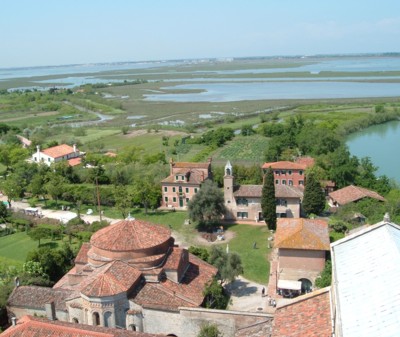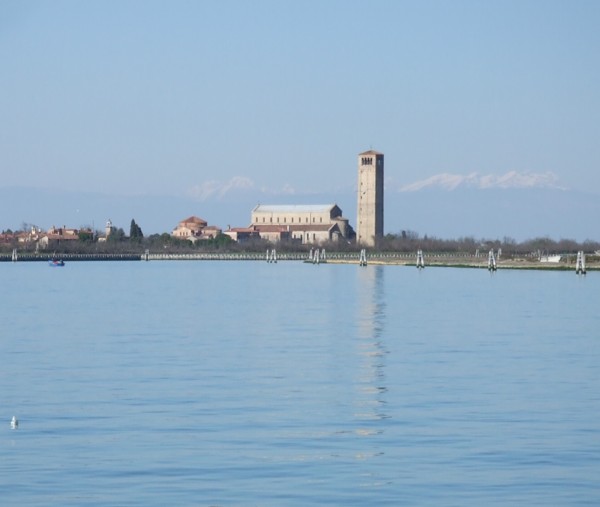Torcello is the most intriguing and the most atmospheric of the islands in the Venetian lagoon. Up in the northern lagoon, choked with mud flats and marshes, this silent island was once a busy and important town. Torcello, combined with its neighbouring island Burano, makes a great trip from Venice (more about transport to Torcello further down this page). Nowadays so different to glamorous Venice, their history is nevertheless shared.
Torcello was first settled by the inhabitants of Altino (Altinum), a once-important Roman town. Led by their bishop, they fled successive invasions which laid waste their mainland homes, and built their new town on this island. Over the years, however, Venice grew more important while Torcello found its waterways silting up and its swamps malarial. Eventually the residents of Torcello packed their bags (and even, supposedly, their homes) and took them south over the lagoon to sites nearer the hub of trade and politics. Nowadays just a handful of residents remain; the town’s piazza is overgrown with grass and weeds, and the two churches of Torcello stand in magnificent isolation.
Alighting at Torcello’s ferry stop, you find yourself at the end of a path and canal, both leading to the heart of the island. Check the time of the return boat or you may have a long wait. Apart from one or two buildings along the way, the landscape is mostly field and marsh. It is very hard to imagine the bustling town that stood here. It’s not until you arrive in the main piazza that any signs of urban history emerge.
In the dusty piazza stands one of the most impressive and interesting churches in the Venice area, the Basilica of Santa Maria Assunta. Founded in the seventh century, today’s cathedral mostly dates to an eleventh-century reconstruction. A section of the earlier mosaic floor can be viewed through a glass panel. On the walls and apse are some fantastic mosaics which would make the trip worthwhile on their own: a lovely Madonna and Child on a gold background, and a scary depiction of the Last Judgement with details such as serpents crawling through skulls.

The Church of Santa Fosca, next door, is very different but also lovely. This small church, which also dates to the eleventh century, is built to a Greek-cross plan and fronted by a later portico.
The campanile (belltower) of the basilica is a steep climb up sloping ramps, but the view over the island and lagoon is worth the effort, even if your legs ache afterwards. The museum over the square is also worth visiting; it has a small collection of archaeological finds and historical items from the cathedral, the lagoon and the surrounding area.
Each individual attraction has a small admission fee at the time of writing. You can also buy a combined ticket for the museum, basilica and campanile. Those who are nervous of heights can pay for a combined museum and basilica ticket. The museum is open 10am-5pm (November-February), 10:30am-5:30pm (March-October), and is closed Mondays and public holidays. The churches and belltower have roughly the same opening hours: arriving any day between 10:30am and 4pm should find them all open. Check the latest times online before you travel.
One of the lagoon’s most renowned restaurants, the pricey Locanda Cipriani, is in Torcello, where the main canal meets the piazza. If you are prepared to brave the mosquitoes, there are also a couple of cheaper restaurants where you can eat outdoors on Torcello; otherwise hop on the boat back to Burano where there is a bigger choice of restaurants and picnic spots.

Travel to Torcello
If you’re starting your journey in Venice, you first need to travel to Burano. The easiest way is to take the LN (Laguna Nord) ferry from the Fondamenta Nuove stop on Venice’s northern shore (there are several different ferry stops so make sure you have the right one). The boat is bigger than the city’s normal vaporetti, and has a few seats outside. Normal Venice ACTV transport tickets are valid for the journey. Ferries run every half hour, and the journey time to Burano is 42 minutes. If you wish to visit the island of Mazzorbo first, you can alight there and continue to Burano on foot via a bridge. A larger boat links Burano with the Lido, heading along the outer edge of the lagoon.
From Burano you then take another ferry, the T, which makes the short journey across to Torcello. Be very careful which boat you get on, and don’t be hesitant to query your destination with the boat staff. Different ferries share the same stop in Burano and their timetables sometimes coincide.
On this site
Useful external links
